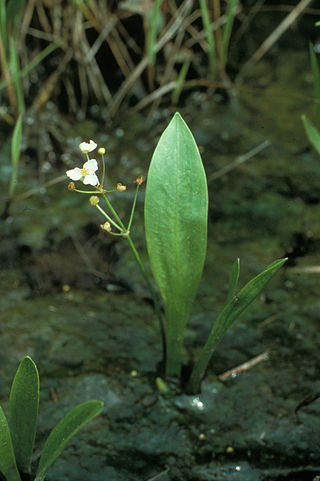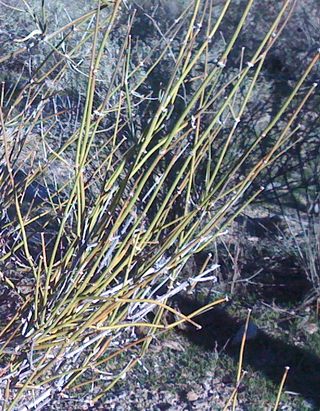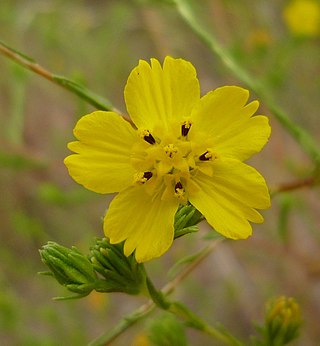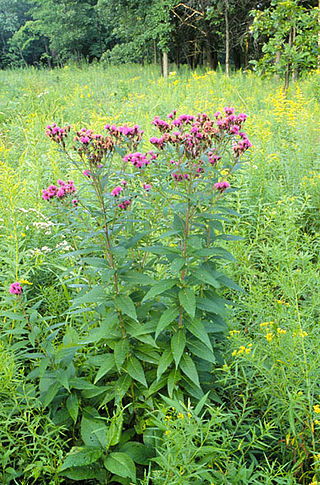
The adrenal cortex is the outer region and also the largest part of an adrenal gland. It is divided into three separate zones: zona glomerulosa, zona fasciculata and zona reticularis. Each zone is responsible for producing specific hormones. It is also a secondary site of androgen synthesis.

The zona fasciculata constitutes the middle and also the widest zone of the adrenal cortex, sitting directly beneath the zona glomerulosa. Constituent cells are organized into bundles or "fascicles".
Banksia fasciculata is a species of column-shaped shrub that is endemic to Western Australia. It has hairy stems, crowded, prickly leaves, yellow flowers and hairy fruit.

Sagittaria fasciculata, the bunched arrowhead is a plant found in wetlands. This plant produces edible tubers that were heavily collected by the Native Americans as a food source. STATUS: Endangered, Federal Register, July 25, 1979

The long-tailed porcupine is a species of rodent in the family Hystricidae. It is monotypic within the genus Trichys, and is found in Brunei, Indonesia, and Malaysia.
Crithidia fasciculata is a species of parasitic excavates. C. fasciculata, like other species of Crithidia have a single host life cycle with insect host, in the case of C. fasciculata this is the mosquito. C. fasciculata have low host species specificity and can infect many species of mosquito.

Prunus fasciculata, also known as wild almond, desert almond, or desert peach is a spiny and woody shrub producing wild almonds, which is native to western deserts of North America.

Orobanche uniflora, commonly known as one-flowered broomrape, one-flowered cancer root, ghost pipe or naked broomrape, is an annual parasitic herbaceous plant. It is native to much of North America, where it is a parasitic plant, tapping nutrients from many other species of plants, including those in the families Asteraceae and Saxifragaceae and in the genus Sedum. The name "orobanche" can be translated to "vetch-strangler" and "uniflora" can be translated to "single-flower".

Ephedra fasciculata is a species of plant in the Ephedraceae family. Common names are Arizona ephedra, Arizona jointfir, and desert Mormon-tea.

Chamaecrista fasciculata, the partridge pea, is a species of legume native to most of the eastern United States. It is an annual which grows to approximately 0.5 meters tall. It has bright yellow flowers from early summer until first frost, with flowers through the entire flowering season if rainfall is sufficient.

Tillandsia fasciculata, commonly known as the giant airplant or cardinal airplant, is a species of bromeliad that is native to Central America, Mexico, the West Indies, northern South America, and the southeastern United States. Within the United States, this airplant is at risk of extirpation from the Mexican bromeliad weevil, Metamasius callizona.

Deinandra fasciculata, known by the common names clustered tarweed and fascicled spikeweed, is a species of flowering plant in the family Asteraceae native to western North America.
Hirtaeschopalaea is a genus of longhorn beetles of the subfamily Lamiinae, containing the following species:
Hirtaeschopalaea albolineata is a species of beetle in the family Cerambycidae. It was described by Maurice Pic in 1925. It is known from India, Vietnam, Borneo and Laos. Its body is typically black and yellowish brown with a gray and white belly.
Hirtaeschopalaea borneensis is a species of beetle in the family Cerambycidae. It was described by Stephan von Breuning in 1963. It is known from Borneo.
Hirtaeschopalaea celebensis is a species of beetle in the family Cerambycidae. It was described by Stephan von Breuning in 1969.
Hirtaeschopalaea dorsana is a species of beetle in the family Cerambycidae. It was described by Holzschuh in 1999.
Hirtaeschopalaea robusta is a species of beetle in the family Cerambycidae. It was described by Stephan von Breuning in 1938.

Vernonia fasciculata, the smooth ironweed or common ironweed, or prairie ironweed is a species of perennial plant in the family Asteraceae. It is native to Manitoba in Canada and the north-central U.S.A.

Vulpia fasciculata, the dune fescue, is a species of annual herb in the family Poaceae. They have a self-supporting growth form and simple, broad leaves. Individuals can grow to 0.24 m.










